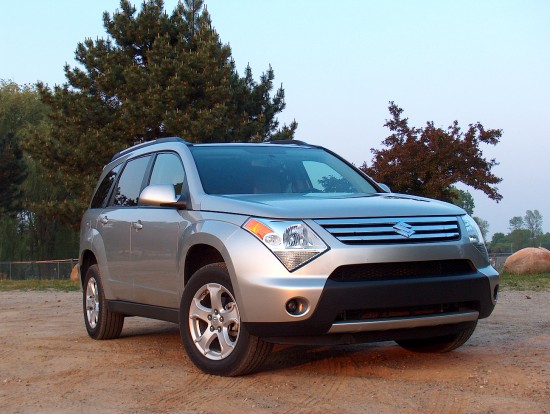2007 Suzuki XL7
Stiff Competition Makes Life Difficult For The Improved XL7
Here’s a good example of just how competitive the auto industry is in 2007. Let’s be honest, Suzuki’s XL7 has been rubbish since it debuted. But when the details on the new generation started to leak out there was a lot of reason for hope. The whole thing was going to be based on a stretched version of GM’s Theta architecture, which works fine in the Chevy Equinox, and even better news was Suzuki’s decision to drop their old, underpowered engine in favor of GM’s 3.6-liter V6 and smooth shifting 5-speed automatic.
Soon after we saw a few pictures and the interior looked approximately 1,000 percent better than the old XL7, and the exterior, minus the different-for-the-sake-of-being-different headlights looked contemporary and, well, nice. We agreed that with Suzuki’s warranty and a rock bottom Suzuki price the XL7 could be a serious option for a shopper in the mid-size crossover market.
And then we drove it. Or more accurately, we drove other new crossovers. See, the XL7 isn’t horrible. The problem is Suzuki priced themselves into a league of very good new alternatives from Ford, Toyota and GM. For example, the Saturn Outlook starts at $27,990. It has more power, better fuel economy, much more interior space, far better interior materials, more comfortable seats and it costs $1,559 less than the XL7. True, you’d have to add all-wheel drive and a rear DVD player to make these apples comparable, but you get the idea.
Mechanically the XL7 was pretty good. The DOHC all-aluminum V6 borrowed from GM and modified only slightly is rated at 252 hp and 243 lb-ft of torque. We never longed for more power partially because Suzuki keeps the weight under control. Our loaded all-wheel drive XL7 weighed 4,049 pounds. The smooth Aisin 5-speed automatic hustled the XL7 to 60 mph in 8.0 seconds, which is just fine for this type of vehicle. The engine can get a little loud, but we suspect most of that is due to less sound deadening material than the class leaders use.
The brakes were all right with stops from 60 mph taking 130 feet and the pedal feel was average for the class, but the logbook had notes about the overly boosted steering at highway speeds which required plenty of little corrections to track straight and true, especially if there were crosswinds.
The MacPherson strut front and multi-link rear suspension provided a fine ride, although wind and road noise could be intrusive at times, another sign that the sound deadening material could be upgraded. We applaud Suzuki for including plenty of electronic safety systems including ABS with Electronic Brake Distribution, Traction Control, Tire Pressure Monitoring and an Electronic Stability Program.
We’ve already given you our take on the exterior. We think some revision to the headlights would be all it would take to turn this into a handsome crossover. The interior is another story. Design is not at fault here; poor materials and assembly don’t hold up their end of the bargain. We noticed several misaligned panels and trim pieces and laughed at the chintzy plastic wheel that dims the instrument panel lights. The front seats are well shaped, but several riders judged them a bit too hard and Suzuki continues to use a particularly cheap grade of leather. The second row seats are flat and hard. The third row isn’t as tight as we expected, but it’s not comfortable for adults. The plastic that make up the dash and door panels is rock hard and the small glovebox didn’t close easily.
That may sound like we didn’t like anything inside, but that’s not true. Suzuki has sourced several components from GM and these days that is a good thing. There’s the easy-to-use radio that also plays MP3s and has seven speakers, straightforward climate controls and a steering wheel with audio and cruise controls. We also liked the large mirrors and good cup holders.
Of course you get what Suzuki reckons is the best warranty in America; a transferable 100,000-mile or 7-year promise that includes roadside assistance. A couple of times when we turned on the air conditioning the compressor made a grinding noise for a few seconds, so we suspect the generous warranty might be put to use on our tester before long.
So what we have here is an XL7 that finally drives pretty well and looks pretty good, but falters in the details and costs as much as competitors that are simply better. If Suzuki could price our XL7 at $26,900 instead of $29,549 we’d be more willing to overlook the inferior interior materials. As it sits, shoppers looking for a good crossover will have to look elsewhere. Suzuki, sadly, doesn’t offer one.
| The Good: |
| Good GM powertrain, some good GM interior components, useful mirrors. |
| The Bad: |
| Engine, wind and road noise, appalling interior materials, stiff seats, costs too much. |
| The Verdict: |
| Can’t match its competitors in anything but price. |















